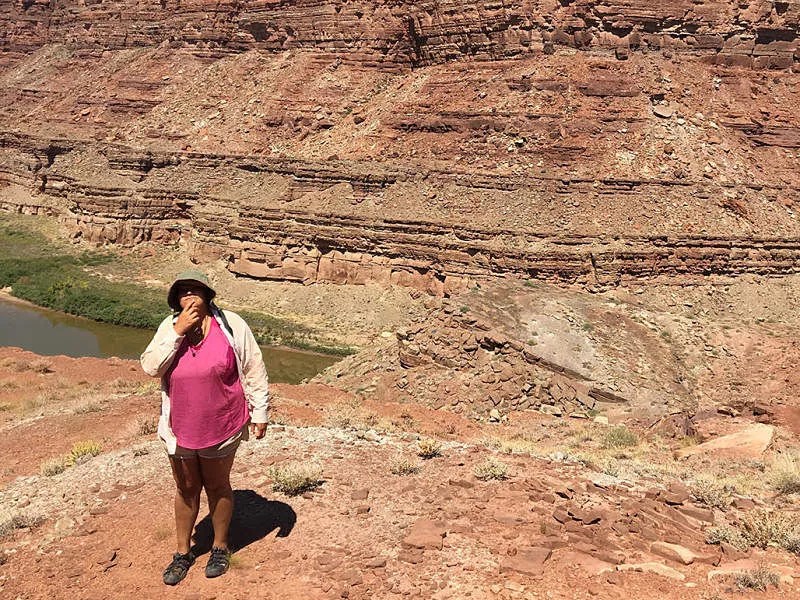
Ethan Pierce

Audio By Carbonatix
Desolation Canyon was just starting to stir when April McMullen awoke at her campsite on a cool morning last August. Groggy and dirty, her arms aching from two days of paddling, the seventeen-year-old wandered down to a remote bank off the Green River to watch the rising sun paint the canyon’s steep walls with the colors of the Southwest: copper, gold, gray, umber and ocher.
Down in the ravine, the water reflected the cliffs and the sky. “It was beautiful,” McMullen says. “Just beautiful.”
She was the first one up that morning, the third day of a two-week, 192-mile Southwest Rafting & Kayaking course she’d enrolled in through the Colorado Outward Bound School.
After honing their skills on Class 1 rapids, McMullen and her COBS team would be hitting Class 2 and 3 rapids for the remainder of the trip. It was an intimidating prospect for a young woman who’d only started rafting two days earlier. She remembers looking out at the water, clutching the life jacket that she’d put back on in a couple of hours and having “little chills,” she says, “like when you’re getting strapped in for a roller-coaster ride.”
COBS is the local branch of Outward Bound, a national organization aimed at “delivering challenging outdoor adventure programs for people of all ages and walks of life.”
McMullen is one of the “all walks of life” people. “I’m biracial,” she explains. “Even though I don’t look African-American, I still identify as both white and Black.”
McMullen’s father is white, her mother Black, and the two divorced when she was nine. After spending her early years in a two-story house in Austin, McMullen moved with her mother and two siblings to Rockport, Texas, where “we bounced from a trailer home to motels, and then for a while we were homeless,” she recalls. “I had to bring trash bags of dirty clothes to school so my guidance counselor could wash them.”
Things got even worse when McMullen’s mother moved in with an abusive boyfriend and her drug habit spiraled out of control. “I’ve been in and out of the foster-care system since I was eleven,” McMullen explains. “But each time I went through the system, I was returned home.”
When her mother relocated to Colorado with her boyfriend, McMullen hung back to finish the eighth grade in Rockport. By the summer of 2016, she was homeless, this time on the streets of San Antonio. After two rough weeks, a stranger took her in, and then the do-gooder bought McMullen a plane ticket to Colorado, where she was reunited with her mother.
Colorado’s child protection system opened a case for McMullen a few days after her sixteenth birthday, and she wound up in a foster home – again.
“I went with a mentor I was seeing from school,” McMullen says. When that didn’t work out, she was sent to a treatment home for girls coming out of jail and sex trafficking. “I didn’t belong there,” she says. “So I worked the program in a month and a half, and from there I went to a group home in Lakewood.”
McMullen was attending high school at Alameda International Junior/Senior High School while working two jobs, spending as little time as possible at the group home. But after seven months, she was kicked out – for false allegations, she says – and placed with her therapist. Finally, she moved in with a former boss from Lakewood breakfast joint Sunrise Sunset.
“I didn’t know what to expect. I thought it was an easy kayaking trip.”
One day, a COBS instructor came to speak at an independent-living group meeting that McMullen was attending through Denver’s court-appointed special-advocate program. It was there that she learned about the ASCEND scholarship program, which offers full rides to kids who can’t afford the hefty COBS course fees, which start at $3,800 for a two-week trip. She thought the Southwest Rafting & Kayaking course “sounded interesting,” she remembers. “I didn’t know what to expect. I thought it was an easy kayaking trip.”
She wasn’t looking for an intense wilderness experience. She just needed “a break from reality,” she says. “I was going through a really hard time, and therapy wasn’t working.”
Growing up, McMullen hadn’t had many opportunities to connect with nature. With just buying food a struggle, she wasn’t exactly in a position to secure the expensive gear needed to backpack, mountain-bike and rock-climb through the wilderness.
Money was a bigger obstacle than skin tone. “Nobody told me I couldn’t go into the wilderness because I was Black,” McMullen explains.
But ASCEND, launched in 2013 in partnership with local schools, was specifically designed to allow more kids of color to attend COBS courses. In 2019, when COBS had a total of 1,426 people enroll in programs, more than 330 were there through ASCEND scholarships.
The course McMullen took was her first “real outdoor experience,” she says. It was intense. And totally life-changing.
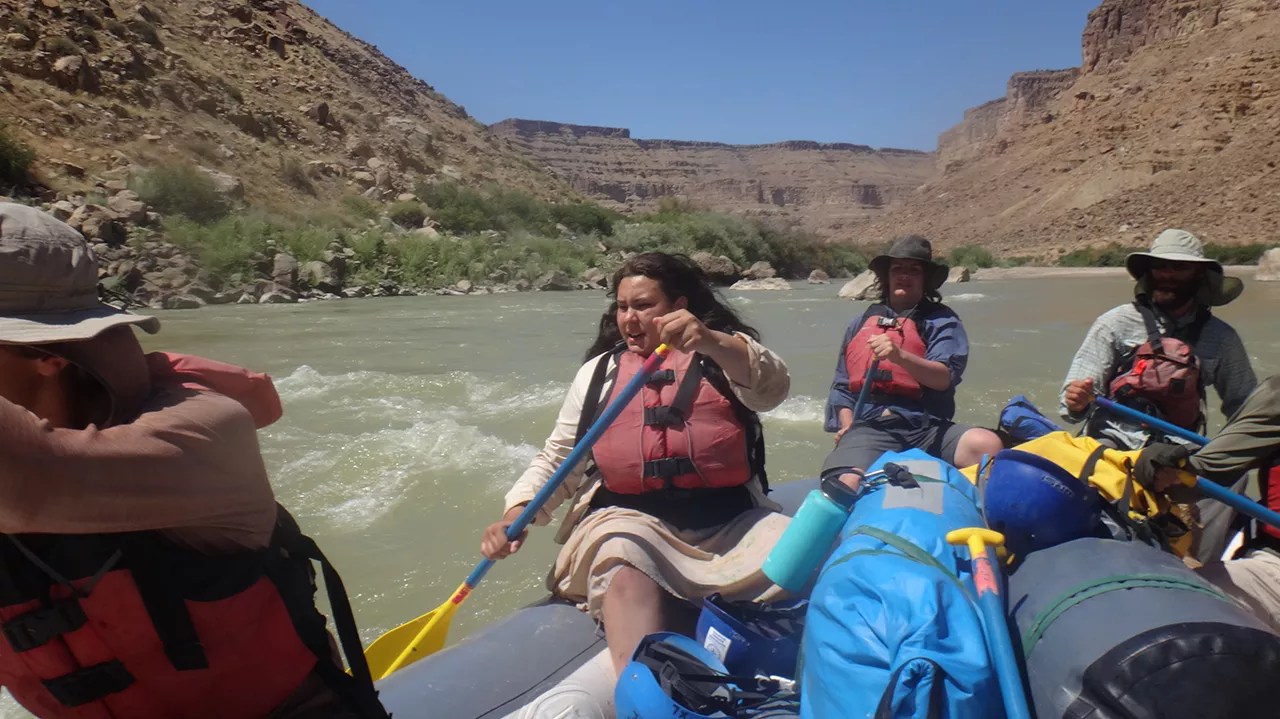
The course April McMullen took was her first “real outdoor experience,” she says.
Megan Macomber
In 1962, Colorado Outward Bound School opened a base camp in Marble. It was the first location of Outward Bound in the country.
Kurt Hahn, a Jew who’d fled his native Germany for England as the Nazis took over, had made an interesting observation as war broke: When Germans attacked British ships in the Battle of the Atlantic, older sailors survived at far higher rates than their younger counterparts. The older men were more resilient and had better survival skills, Hahn noticed. Working at a Scottish boarding school in the early ’30s, he’d come up with a curriculum that emphasized development of character. In 1941, he expanded that to introduce a new kind of program in Wales: a one-month course that would “foster physical fitness, enterprise, tenacity, and compassion among British youth,” according to the website of what grew into Outward Bound USA.
Twenty years later, Josh Miner, an educator who’d worked with Hahn, brought Outward Bound to the United States with help from several prominent Coloradans: Bill Coors, Chuck Froelicher and Charlie Gates. The state’s rugged backcountry was a perfect place to turn the next generation of American boys into men, they believed; an organization called the Atlantic Foundation for Education of the Free bankrolled the project.
“Essentially, the Atlantic Foundation was a group of East Coast prep-school educators who were aware of what Hahn was doing in England, and they helped raise some of the money that allowed COBS to be founded,” explains Ben Fickett, COBS’s director of admissions. “All of our first students were male, and most of the first instructors were not only men, but white men from military backgrounds. The outdoors in general looked like this.”
But there were exceptions. After earning the Congressional Gold Medal for her time in the Women’s Air Force Service Pilots program during WWII, Ruth Humphreys Brown and her husband, D.R.C., helped establish the Colorado program. In 1969, Ruth Brown was a participant in COBS’s first women-only adult course. By the early ’70s, COBS was running regular courses for women, and even hiring female instructors to lead expeditions.
As COBS was getting established in Colorado, the Atlantic Foundation was busy setting up additional Outward Bound schools throughout the country (eleven in all by 1970), which ran largely independently. Most of the schools, particularly Colorado’s, grew over the next two decades as interest in wilderness activities grew. But the boom in outdoor recreation also led to considerable competition, and enrollment in all of the regional Outward Bound units dropped.
Ultimately, a series of mergers brought the regional Outward Bound schools together under a single 501(c)(3) charter in 2003, essentially turning eleven independent entities into one big national organization, Outward Bound USA, now headquartered in Golden. “My understanding is that the merger was intended to generate some administrative efficiencies,” says Fickett. “There was also a theory that Outward Bound would be able to raise more money as a national brand.”
Instead, the merger had unexpected costs for COBS. “When we went national, we didn’t have anyone doing grassroots outreach anymore,” explains Fickett. “We lost a lot of connections to our community.”
“When we went national, we didn’t have anyone doing grassroots outreach anymore,” explains Fickett.
In 2012, the merger was reversed, and the country’s Outward Bound schools again began operating autonomously, though Outward Bound USA continued to oversee safety at regional schools, as well as do brand management and some limited fundraising.
When COBS regained control of its wilderness school, the organization was on the verge of financial ruin. “We basically started from the ground up,” Fickett says. “We were focused on recruiting any students we could get. It took us a couple of years to get our financial footing…and now we’re back to focusing on social justice issues.”
Back in 1985, COBS had launched a diversity program to recruit instructors of color, and also began recruiting students of color. That effort had stalled, but focusing on serving a new group of inner-city youth now looked like a possible path to a comeback. Emphasizing younger participants, from older students to youth ages twelve to sixteen, also seemed promising.
Lauren Schmidt became executive director of COBS in December 2019. She joined Fickett in working on ways to promote equitable access to the outdoors, including the ASCEND scholarship program; together they continued the shift to younger students, and also began rolling out shorter wilderness expeditions. “We need to focus more on our Colorado community, and that’s part of my vision,” says Schmidt.
To reach more kids in their own back yard, COBS created three- to five-day introductory courses for school groups and nonprofits from Denver, Leadville, Colorado Springs and the Roaring Fork Valley. Eighty-five percent of the students served through COBS’s school courses are students of color, and 95 percent are eligible for free or reduced lunch. What is really encouraging, Schmidt says, is that “many students who come on a short school trip will then apply for a scholarship for a longer program.”
On those longer trips, they often met with participants from around the country; only about 20 percent of students paying full tuition on COBS courses were from Colorado. “One thing that’s unique about Outward Bound,” Fickett says, “[is] you can get a truly diverse student group. When you can put together a group of kids, all from different places, who don’t have much in common, that’s when you get the really interesting conversations.
“I just don’t think that happens in our society much anymore.”
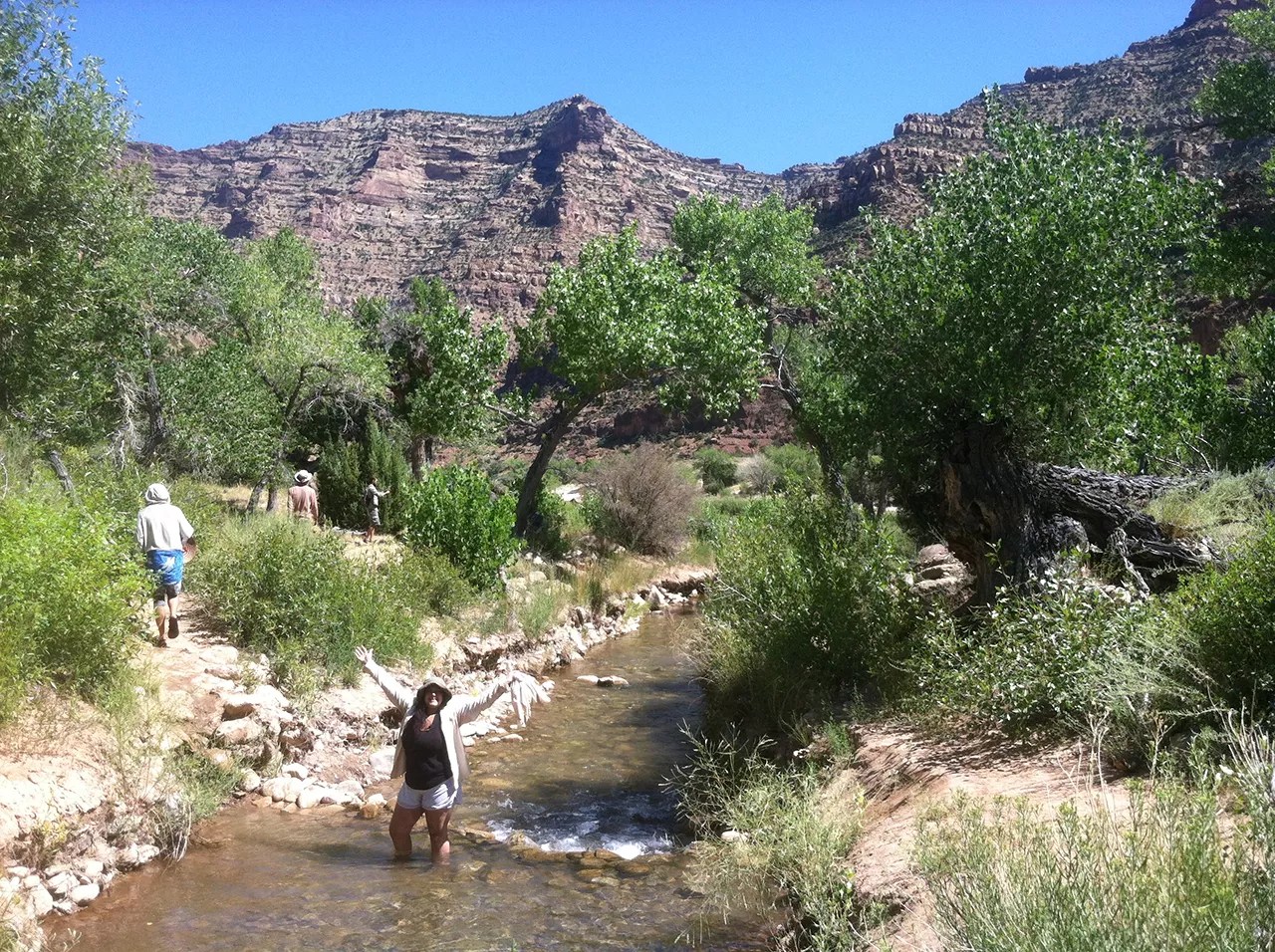
April McMullen was one of six students to complete the COBS Southwest Rafting & Kayaking course last August.
Ethan Pierce
April McMullen was one of six students to complete COBS’s Southwest Rafting & Kayaking course last August. It was a little bit like The Real World on water.
“I met five individuals I’d never seen, all from different states, and we had to work together to paddle 192 miles,” she says. Paddling alongside McMullen were two white teenage girls – both East Coasters from “privileged backgrounds,” she surmised – as well as a white teenage boy from Rhode Island, a student who self-identified as Latinx and another who identified as Latinx and Caucasian.
“It was a unique group. Everyone had a different personality,” says McMullen. “Sometimes we did not get along.”
She has “a hard time making friends,” she admits. “But I created special bonds with new people and the instructors.”
The three instructors were all white males, one of whom also reported “American Indian, Native American, or Alaskan Native” heritage.
Of COBS’s pool of 230 staff instructors, 91 percent are white. “Most of our instructors are recent college grads who are interested in working in the outdoor industry,” explains Schmidt. “We don’t hire nearly enough diverse instructors. That’s partly because the outdoor industry is a largely white industry, and the job doesn’t always attract people of color.”
To counter that, COBS launched its Fellowship Program for People of Color in 2019, with a goal of hiring and retaining more Black and brown instructors. Through the program, Schmidt explains, “we hire diverse instructors, then support them by pairing them with a mentor and providing paid training, travel and gear stipends.”
During its first season, COBS brought on six new instructors through the fellowship program. “Five fellows would have come back this summer, if we were running programs in 2020,” Schmidt says.
But thanks to COVID-19, COBS isn’t offering those fellowships.
Instead, it’s focusing on what can work during a pandemic. COBS’s signature Rockies to Ecuador Leadership Semester, for example, used to be an 81-day journey across three states, two countries and countless miles of trail. For this year’s program, “students will only be in Colorado and Utah, and the length of the course has gone from 81 to 72 days,” Schmidt says.
“We’ve also rolled out some new programming to address diversity, equity and inclusivity issues head on,” she notes, including training seminars that cover micro-aggression, privilege and power.
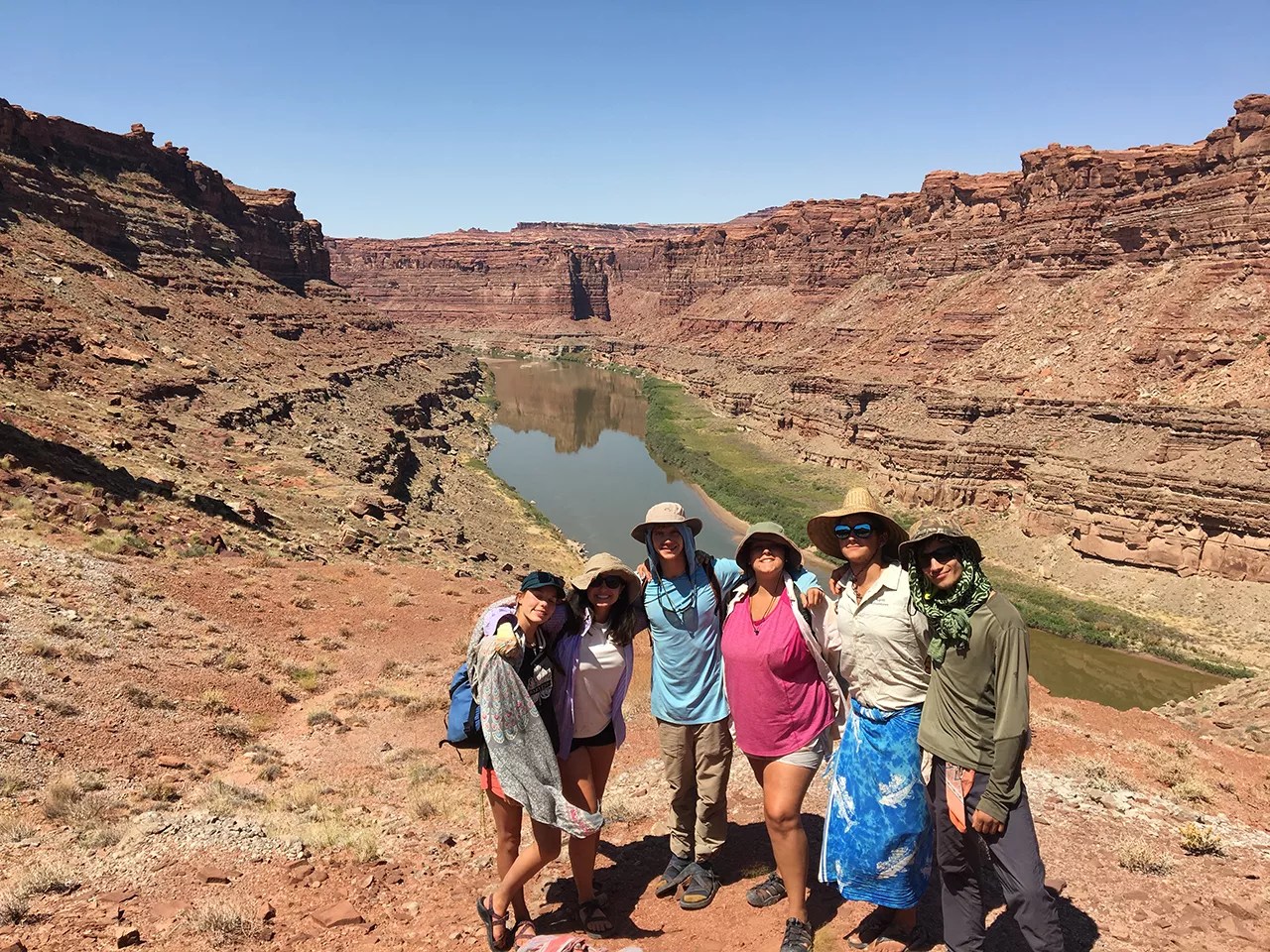
April McMullen bonded with others on the trip.
Ethan Pierce
While Colorado Outward Bound was finding its way back from the brink, city and state agencies devoted to the outdoors were recognizing that they had a new mission.
“We’ve got to give kids the ability to see themselves in nature,” says Scott Gilmore, deputy executive director for Denver Parks and Recreation. “It’s a critical piece to everybody’s health to be able to experience the outdoors.”
As a young person of Black and Japanese heritage growing up in Denver’s Montbello neighborhood, Gilmore didn’t have ready access to nature.
“The outdoors was something for white people to enjoy,” he remembers. And not only did nature seem far away, but the land nearby was full of environmental hazards. “Waste dumps, power plants, landfills…these are the things you find in urban Black neighborhoods,” he adds, referencing the Rocky Mountain Arsenal, which flanks Montbello’s northern boundaries.
“It was one of the worst toxic dumps in the world, and the neighborhood I grew up in was built right next to it in the 1960s,” he says. While the vast majority of the chemical weapons manufacturing site has since been cleaned up and turned into a wildlife refuge, Gilmore notes that “there are still sections that are so toxic, they will be closed to the public forever.”
Today Montbello is greener than it was during Gilmore’s childhood, and a lot of that is thanks to his ongoing efforts to bring nature directly to neighborhood kids.
After graduating from Colorado State University with a bachelor’s degree in wildlife biology in 1994, Gilmore joined Colorado Parks and Wildlife as the statewide angler education coordinator. During his eighteen-year tenure with that state agency, Gilmore developed Fishing Is Fun, a program designed specifically for youth who are new to the activity.
Gilmore met his wife, future Denver City Council rep (and now president) Stacie Gilmore, through the Fishing Is Fun program. “We started spending more time together, enjoying the Colorado wilderness,” Gilmore recalls. “We decided we shouldn’t be the only ones from our neighborhood who got to spend so much time outdoors.”
In 1996, the Gilmores founded Environmental Learning for Kids at their kitchen table. The nonprofit focused on a hyper-local immersion into nature, teaching urban youth (particularly girls in Montbello) and kids of color about science, nature and social justice through hands-on activities such as fishing, hiking and outdoorsy service projects.
In the beginning, ELK was just the Gilmores delivering on-site wildlife programming at a handful of public schools in Denver’s urban core. Then they began leading nature-based field trips, as well as overnight campouts for the entire family to enjoy. ELK grew from there; today the nonprofit serves more than 5,000 kids annually in Denver, Aurora and Commerce City. The Gilmores remain involved, but no longer run ELK.
“Waste dumps, power plants, landfills…these are the things you find in urban Black neighborhoods.”
“I was always just a glorified volunteer,” says Scott, noting that he never drew a paycheck from the nonprofit.
After winning her seat on Denver City Council in 2014, Stacie stepped down from her role as ELK’s executive director; Loretta Pineda now leads the organization. ELK’s mission is still centered on bringing nature directly to area youth rather than taking them into the wilderness. In 2016, ELK broke ground on Montbello Open Space Park, the neighborhood’s first park of its kind – a five-acre plot with hiking and biking trails, a restored native prairie, educational kiosks, nature-based play areas, a pavilion, a climbing wall, and ELK’s new headquarters.
“The park is fully built, but it’s still fenced,” says Gilmore. “We’re waiting for the natural landscapes to grow in.”
The open space should be operational sometime next year; in the meantime, ELK is hosting programming there.
While Gilmore would like to see more inner-city residents have access to the outdoors, he doesn’t think that a COBS trip through Colorado’s rugged wilderness is suitable for many of the local youth with whom he’s worked. “COBS has a vision of what they should do with kids,” he says. “But if you aren’t connecting them to nature in their community first, why would they want to go into the backcountry?”
When the Gilmores founded ELK, there was a major disconnect between Denver’s urban core and the Colorado foothills and mountains, he notes. The Denver Department of Parks and Recreation was “a lot more traditional,” using tax dollars to place recreation centers and groomed fields in primarily white communities.
But as COBS fell behind the times during the national merger period, Denver Parks and Recreation caught up…and moved ahead.
Shortly after taking office in 2011, Mayor Michael Hancock hired Gilmore to lead the parks side of Parks and Recreation.
With the blessing of Colorado Parks and Wildlife, Gilmore transformed the state’s Fishing Is Fun program into a Denver-sponsored offering that’s still going today. Then he began brainstorming ways to get more programming to the city’s underserved youth. Some were very underserved: The Westwood neighborhood, for example, lacked even a basic a recreation center in 2011.
“We had to think outside the box,” Gilmore recalls. And that meant moving programming outside.
As Gilmore and his staff developed nature-based programming throughout neighborhoods in Denver’s urban core, Parks and Recreation simultaneously began putting green spaces into concrete jungles, while also pushing the city’s assets in the foothills. “We own 14,000 acres of Denver Mountain Parks,” Gilmore says. “Instead of keeping kids in rec centers, we want to see them out hiking, snowshoeing, paddleboarding…doing all of the great things that people in Colorado love to do.”
Meanwhile, ELK began collaborating with a Golden-based nonprofit, Big City Mountaineers, to provide wilderness expeditions for under-resourced youth from Denver and, eventually, six more cities across the country. Other organizations with similar missions also popped up. Finally, in 2017, Denver Parks and Recreation decided it was time to connect the dots by establishing My Outdoor Colorado, a collective of nonprofits that have come together to provide free programming for inner-city youth out in nature.
Sixteen organizations currently make up the collective: Boys & Girls Club of Metro Denver, the Greenway Foundation, cityWILD, GRASP, the Kiva Center, Mile High Youth Corps, Groundwork Denver, the National Wildlife Federation, Lincoln Hills Cares, ViVe Wellness, Seeds of Power Unity Farm, Annunciation School, Volunteers for Outdoor Colorado, Wyatt School, Latino Outdoors and Denver Parks and Recreation.
For My Outdoor Colorado, Parks and Recreation surveyed residents of the Cole and Westwood communities, asking about barriers they faced when attempting to access the outdoors. Gear and transportation were the two most common obstacles.
Most outdoor recreation activities require specific equipment – often expensive specific equipment. “You have groups that will come into urban communities to expose a few kids to an outdoor adventure activity,” Gilmore points out. “Their hearts are in the right place, but they come to a community with a small grant and no followup. They teach a young Black girl how to fly-fish, but who is going to pay for her to continue fishing…and transport her to and from the water every weekend so she can practice?”
Parks and Recreation has taken a crack at solving this by building a gear library in a shipping container in the Westwood neighborhood stocked with paddleboards, climbing shoes, cross-country skis, tents and camping equipment. Members of the My Outdoor Colorado collective can check out gear to use with community members who participate in their programming. And since a large part of My Outdoor Colorado’s in-kind services are transit-related, participants are often provided with rides to and from outdoor destinations.
My Outdoor Colorado is funded by grants from the Colorado Lottery’s GOCO funding, which initially provided $2,179,077 for place-based projects and programming in the Cole neighborhood and another $3,700,000 for Westwood-specific events. Denver Parks and Recreation put up additional cash – $500,000 and $900,000, respectively – for the neighborhood programming. When in-kind donations from members of the collective are factored in, the total funding reaches $7,505,880 over a three-year period.
The GOCO grant is only temporary, though. “We’ve come together to start strategizing for the future and put up another application to continue GOCO funding,” says Leslie Pickard, director of recreation for Denver Parks and Recreation.
Denver has the numbers to back its pitch: Before launching the My Outdoor Colorado program in 2017, Denver Parks and Recreation served 4,485 people through its in-house programming. “But in 2018 and 2019, we reached 12,557 and 14,319, respectively,” Pickard says.
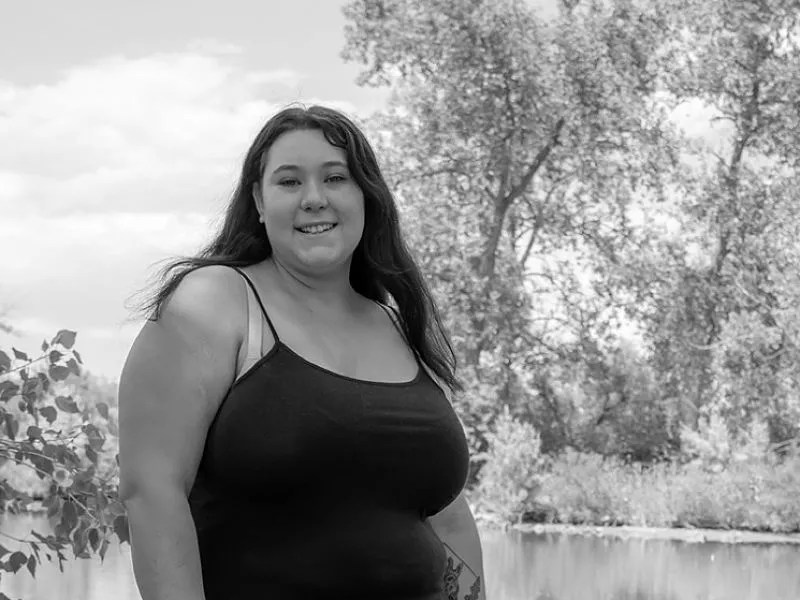
April McMullen found her way in the wilderness.
Michael Emery Hecker
Colorado Outward Bound School isn’t part of the My Outdoor Colorado collective. “It hasn’t come across my radar,” Schmidt says. No one from Denver Parks and Recreation reached out to COBS when the collective was forming, Pickard notes.
But the two organizations certainly know about each other. For nine years, COBS has operated out of a headquarters at Camp Rollandet Natural Area, a city-owned parcel off of Clear Creek in Denver’s Berkeley neighborhood.
This May, Schmidt learned that the city won’t renew COBS’s lease on the property when it runs out in 2021.
As part of its rental agreement, Gilmore explains, COBS was required to submit annual diversity reports to Parks and Recreation. “I’ve asked for the annual reports,” Gilmore says, “and they haven’t come through.”
Denver Parks and Recreation leases out portions of city property to a handful of other organizations, including ELK, the Greenway Foundation and the Park People, which rents the Fleming Mansion in Platt Park. “It’s not super-common, but it’s something we’ll do when there’s an organization that’s benefiting the people of Denver, especially people in communities we don’t have the resources to connect with,” Gilmore explains.
Under their Parks and Recreation leases, most tenants have specific requirements to which they must adhere, but not all requirements pertain to diversity.
At the time COBS signed its lease, the organization was still operating under Outward Bound USA. “All of the traditional wilderness programs were being rolled out through the national organization, and our local COBS was going to become more urban-focused,” says Schmidt, who wasn’t working for COBS at the time. “Shortly after signing its lease with Denver Parks and Rec, COBS regained control of its traditional wilderness programs.”
When that happened, COBS’s urban agenda was put on hold as the nonprofit reinstated its expeditions.
“Under our lease with Denver Parks and Recreation, I’ve found out this year, we were required to conduct three service projects at our facility and three environmental education programs for the public. There was no specific diversity requirement,” Schmidt says. “I think COBS forgot about that, and so did Denver Parks and Rec.”
Actually, Denver Parks and Recreation did not forget. “It was four service projects and four environmental education programs…a year,” Gilmore says. “And then COBS was supposed to file an annual report. This was something we asked them to do.”
“I was constantly reminded of how capable I am. I can do anything in my life.”
So with time running out on the lease and no annual reports coming in from COBS, Denver Parks and Recreation decided that its local programming – programming specifically designed to serve Denver’s diverse population – would be a better use for the Camp Rollandet site. “Their headquarters sits on beautiful land, and my natural-resources team needs more space,” notes Gilmore.
COBS is currently looking for a new home.”Denver Parks and Rec has been great to us,” Schmidt maintains. “As we look at expanding our local programming, I’d like to develop a deeper partnership with them.”
Even if COBS’s new home won’t come with a requirement to hand in diversity reports, diversity remains a key to future organizations focused on outdoor activities. “The Outward Bound program is a great program, but I don’t think you want to just stick kids of color out there in the backcountry without really connecting them to the outdoors in the city first,” says Gilmore. “For people of color, those of us who have grown up in the city, the quiet of nature can be one of the scariest things out there.”
Schmidt agrees: “Something we’ve learned over the years is that it’s really hard – for reasons we at COBS now appreciate – to take students who have never spent time in the outdoors on a week-long trip through the wilderness.

April McMullen “was constantly reminded of how capable I am,” she remembers.
Sophie Macmillan
“A COBS course is hard,” she admits. “Our students are out in the wilderness the whole time, roughing it, though sometimes they’ll have a very short break during an in-town day.”
Schmidt and her team call the COBS experience “Type 2 Fun.” Compared to the type of fun that provides instant satisfaction, a COBS course “might not be at all fun in the moment,” she explains. “But when you look back on it, the experience was meaningful.”
Nearly a year after finishing her Type 2 Fun adventure, April McMullen can confirm that. On the rafting trip, there were plenty of times when she felt like giving up, crying in the raft, her arms sore from days of paddling. She didn’t, though, and as a result, “I was constantly reminded of how capable I am,” she says. “I can do anything in my life.”
She learned much more than how to cope in the wilderness. “The most important thing I got out of it was being able to process and accept years of trauma,” she explains. “Being submerged in nothing but nature, it was the most wonderful feeling. I came back a happier person.”
She finally scraped together enough cash for her own apartment in Lakewood, and she’s even begun reconciling with her mother. “I’ve overcome a lot, and I’m proud of where I am now,” she says.
While COBS might not reach every all-walks-of-life kid in Colorado, the organization certainly succeeded in touching McMullen. “Being in the foster system, moving around a lot, I’d never had the opportunity to really go outdoors,” she says. Now, though, “anytime I feel stressed, I walk to a park near my house and sit on a bridge above the river, just to hear the water flowing.”
A few months after she completed her COBS course, McMullen signed up to work at Yellowstone National Park. “I was going to be a manager of housekeeping for the whole summer at the Old Faithful Inn,” she says.
She’d been looking forward to submerging herself in nature for three months straight, and then a natural disaster hit: COVID-19 wrecked her plans.
But these days, McMullen is a pro at going with the flow. Even though she isn’t living in a national park, she’s out in nature every chance she gets.
“The Outward Bound trip,” she says, “made me realize what I was missing.”